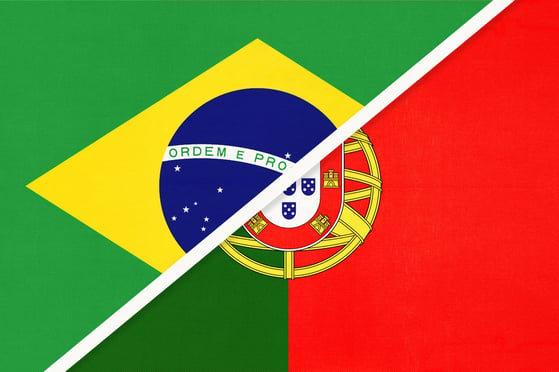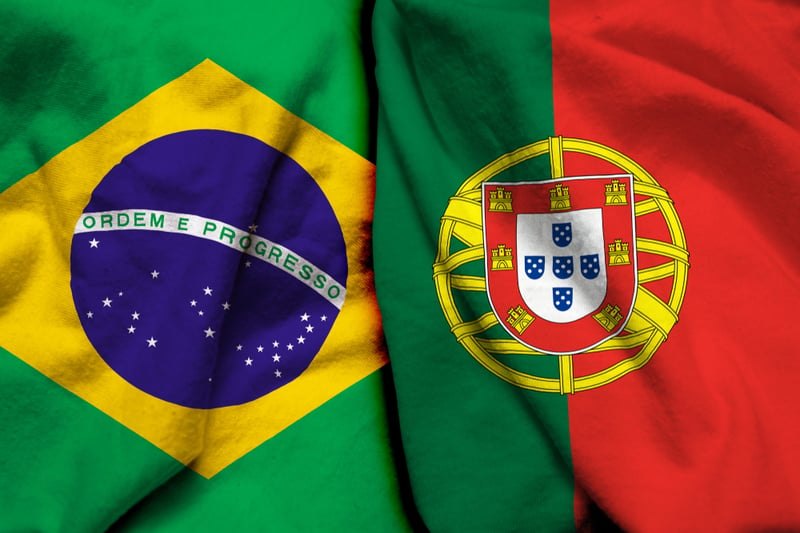What’s the difference between European Portuguese vs Brazilian Portuguese? For starters, European Portuguese is the variant spoken in Portugal and is more similar to the dialects spoken in Africa and Asia. (It is sometimes called Continental Portuguese, or even Portuguese Portuguese! 😄 ) Given the size and population of Brazil, however, the Brazilian Portuguese set of dialects are the most famous across the world, including online and in the entertainment industry.
Some compare the distinction between European Portuguese and Brazilian Portuguese to that between American and British English, or between Latin American and European/Castilian Spanish. Practice Portuguese only teaches European Portuguese, so if you are arriving here with a background in Brazilian Portuguese, it can be helpful to understand the differences.
For native Portuguese speakers, the various dialects are mutually intelligible. As a non-native, hearing multiple versions can sometimes add extra confusion and complexity to the learning process, particularly when it comes to the pronunciation differences. If you’re planning to spend time in Portugal, or you just want to learn more about the Portuguese language as a whole, it’s important to understand the many unique characteristics of European Portuguese. We’ll take a look at some of the primary differences in spelling, grammar, vocabulary, and pronunciation.
Bear in mind that EP and BP each include their own variety of dialects as well, so there will be some generalizations for simplicity’s sake. For that same reason, we tend to lean toward the “Lisbon accent” and dialect in Learning Notes and Units.
In the examples below, we labeled the Brazilian pronunciations with BP (Brazilian Portuguese). Any examples without this indication are in EP (European Portuguese).
Spelling
With the Acordo Ortográfico de 1990 (Orthographic Agreement of 1990), also known as the Novo Acordo OrtográficoNew Orthographic Agreement , which went into effect in 2008, the written forms of both dialects became practically the same. Many people and publications in Portugal refuse to write under this new agreement, so it’s very likely that you’ll still come across the “old” versions of some words.
One major change was the removal of mute consonants in European Portuguese, mostly p‘s and c‘s, making it more similar to the Brazilian version. For example, ótimogreat used to be written as “óptimo” and açãoaction used to be “acção”. Words such as factofact and contactocontact retained the c in European Portuguese because c is not a mute consonant in such cases.
Grammar
The Pronouns Tu/Teu vs Você/Seu

A major difference between European Portuguese vs Brazilian Portuguese involves the use of second-person pronouns. In European Portuguese, we use the personal pronoun tuyou in informal contexts and with people close to us. We use the “treatment pronoun” vocêyou when speaking to our elderly relatives or people we’re not close with. (These are often referred to as “you, informal” and “you, formal” for simplicity.)
In Brazilian Portuguese, however, você has replaced tu for the most part, and has become an informal way of talking to someone in the second person. Alternatively, and because some people are offended by você, both dialects sometimes make use of o senhor/a senhora to refer to “you”. When using você in either dialect, you conjugate the corresponding verb in the 3rd person.
Tu fizeste o almoçoYou made lunch
Você fez o almoço BPYou made lunch
Similarly, the possessive pronoun/determiner teu, used in Portugal, is replaced with seu in BP:
O teu pai ligou?Did your father call?
(O) * Seu pai ligou? BPDid your father call?
* In BP, the definite articles o/os/a/as that should come before the pronoun are usually not spoken.
Demonstrative Pronouns
In European Portuguese, we use the demonstrative pronouns este, esta, and isto to refer to objects close to us (“this“), and esse, essa, and isso to refer to objects that are a bit further away (“that“). In BP, este and isto are rarely used. Instead, you hear the expressions “esse aqui” or “isso aqui” to refer to objects that are close by, as if saying “that here”. Similarly, for objects not in reach of the speaker, BP combines aíthere with esse and isso, becoming “esse aí” or “isso aí”, as if saying “that there”.
O que é isto?What is this?
O que é isso aqui? BPWhat is this?
Gerund

One of the more obvious differences between European Portuguese vs Brazilian Portuguese is the use of the gerúndiogerund . Brazilian Portuguese makes extensive use of this kind of non-finite verb, while European Portuguese prefers to use the “a + infinitive” structure instead. You can read more in this Learning Note on the Present Continuous.
Ele está a dançarHe is dancing
Ele está dançando BPHe is dancing
Eu continuo a achar que é mentiraI still think it's a lie
Eu continuo achando que é mentira BPI still think it's a lie
Clitic Object Pronouns Before the Verb
In the Clitic Object Pronouns unit, we mention that these types of pronouns can appear in three different positions: before, in the middle, or after the verb. In Brazilian Portuguese, the proclitic (before) position is the standard way, while the enclitic (after) position is the standard in European Portuguese.
Amo-teI love you
Te amo BPI love you
Ele disse-meHe told me
Ele me disse BPHe told me
Eu dou-te os parabénsI congratulate you
Eu te dou os parabéns BPI congratulate you
The pronouns o, os, a, and as are still present in BP, but they are usually replaced with the pronouns ele, eles, ela, and elas. For example:
Eu vi-o ontemI saw him yesterday
Eu vi ele ontem BPI saw him yesterday
When it comes to indirect object pronouns, lhe is rarely found in Brazilian Portuguese. Instead, speakers use the structure “para + personal pronoun”. For example:
Eu contei-lhe o que aconteceuI told him what happened
Eu contei para ele o que aconteceu BPI told him what happened
The Verb Ter as Haver
In certain situations, Brazilian Portuguese makes use of the verb ter in place of the verb haver.
Há muito pó neste quartoThere's a lot of dust in this room
Tem muito pó neste quarto BPThere's a lot of dust in this room
Há muitos estrangeiros em PortugalThere are a lot of foreigners in Portugal
Tem muito estrangeiro* em Portugal BPThere are a lot of foreigners in Portugal
* The use of singular instead of plural forms is also very common.
Using the Preposition em Instead of a
In this Learning Note, you learn how the preposition emin, at combines with the definite articles othe(masc.) and athe (fem.) to form the contractions noin the and nain the . Brazilian Portuguese makes use of these contractions in a way that EP doesn’t. For example:
Vou a casa dos meus paisI'm going to my parents' house
Vou na casa de meus pais BPI'm going to my parents' house
Fui ao cinemaI went to the movie theatre
Fui no cinema BPI went to the movie theatre
Vocabulary

There are many differences between the lexicons of European Portuguese vs Brazilian Portuguese, particularly with neologisms. Over the years, BP has incorporated and adapted English words into its own vocabulary. You’ll notice some of them in the list below. Words such as time (BP), trem (BP), and esporte (BP), while spelled differently, sound almost the same as their English equivalents and have no relation to the European Portuguese words.
- Grass: relvagrass gramaBPgrass
- (Hitch a) ride: boleiaride caronaBPride
- Santa Claus: Pai NatalSanta Claus Papai NoelBPSanta Claus
- Juice: sumojuice sucoBPjuice
- Sport: desportosport esporteBPsport
- Cancer: cancrocancer câncerBPcancer
- Bus: autocarrobus ônibusBPbus
- Cell phone: o telemóvelcell phone celularBPcell phone
- Train: comboiotrain tremBPtrain
- Team: equipateam timeBPteam
Pronunciation

Finally we’ve made it to perhaps the most noticeable difference between European Portuguese vs Brazilian Portuguese: the way they sound. We’ll highlight a few of the characteristic differences in the phonetics of each dialect. (You can also read a little more about what distinguishes European Portuguese in this Learning Note about vowel pronunciation.)
- In European Portuguese, reduced vowels are barely noticeable – it’s as if we swallow them! In Brazilian Portuguese, the vowels sound much more open, making it seem like every syllable is stressed compared to the European variant.
- In BP, the l at the end of a word is often vocalized like a u.
- In BP, the r at the end of a word is usually suppressed.
- In European Portuguese, you will hear the phonemes that correspond to the letters d and t pronounced like: de di and te ti . In BP, however, they are pronounced like djiBP and tjiBP .
- There are a variety of pronunciations for the letter s in European Portuguese, including the “sh” pronunciation when s appears at the end of a word or in the middle before a consonant. In BP, however, the s is pronounced like a z in these contexts.
Accents
Regarding stressed syllables, there’s one major difference when it comes to some “palavras esdrúxulas” – words in which the stressed syllable is the antepenultimate (third from the last) one. In both EP and BP, an accent is present, but the particular accent can vary. Let’s start with a few words that have the same spelling in EP and BP:
The difference appears in certain words that use the acute accent (´) in European Portuguese, but the circumflex accent (ˆ) in Brazilian Portuguese. Consequently, the pronunciation of the word is different too, as the stressed syllables are open in EP and nasalized in BP. For example:
- tónicatonic tônicaBPtonic
- académicoacademic acadêmicoBPacademic
- demóniodemon demônioBPdemon
- António AntônioBP
Compare European Portuguese vs Brazilian Portuguese in Conversation
The rest of our content sticks to EP, but we released these 4 special episodes featuring both European and Brazilian Portuguese speakers. Can you hear the differences? Enjoy!



You mention that people could be offended by the use of ‘voce’
Who would be offended and why ?
In Portugal, você is sometimes seen as being too direct, so alternative forms of saying “you” are preferred. You can read more about it in this unit: Informal and Formal “You”
Thank you so much !
To tell you the truth, my level is not even A1 . Having learnt spanish at a considerably good level I am now interested in finding a way to begin learning portuguese ( the european one) basically on my own, using various platforms and technology tools. Any suggestions?
Olá, Anastasia. Since you already know Spanish, you’ll find a number of parallels between the two languages (but also many deceptive differences!) that might make life a bit easier for you with Portuguese. Practice Portuguese has a number of resources to help you make progress independently, but it’s useful to have some kind of roadmap. This blog post can help you with that: The Easiest Way to Start Learning European Portuguese
Feel free to get back in touch with us via our support channel if you need further help! We’ll be here 🙂
Extremely helpful information for me as I am trying to figure out what the differences are between the two main variants of Portuguese. My conclusion is that it is important to stick to one variant for students of the language. The main reason is the pronunciation differences and the need to make properly pronounced speech automatic,
Nevertheless, at a more advancned level, it seems worthwhile to develop a passive understading of the second variant. I suspect that is what native speakers also develop, i.e., it must be rare that native speakers can switch their speech between the two pronunciation pattersn (a bit like having a Swede speak like a Norwegian or vice versa).
For me, an enjoyable way to start learning Portuguese is via Duolingo. But it offers only Brazilian Portuguese . Your information here is much appreciated. My use of the language will realistically be in Portugal or Madeira, not Brazil. In Europe I may not be very intelligible if I speak but I will have a level of understanding of the written language and native-speakers will likely appreciate the effort to learn it.
I’m an English speaker, with some experience in Italian and was worried at first that this might conflict with Portuguese, but generally, I am not finding this to be a problem .
I recently began learning BP because a coworker/friend of mine is from Brazil. I *just* got comfortable with the pronunciation (I think BP pronunciation is super cute, with all the “ente”s and whatnot) and using “na/no” and “ele/ela”….now I’ve landed a job in Portugal and have to switch to EP! I’ll miss the BP pronunciation and the present continuous form that’s similar to Latin American Spanish, but I’m glad I found this resource to help me with EP.
Duolingo does not identify that the Portuguese they teach is Brazilian Portuguese so I started with them thinking I was learning European Portuguese. I was just corrected by friends living in Portugal so now I will try to learn on your platform. I like their approach to teaching as it was natural and fun. Here is hoping I learn as easily on your site. I find it easier to learn to read and write a language than to speak and understand unless I am in an immersive setting. And will probably be in Portugal for a scouting trip very soon.
Same to me, 4 years ago, I got to my first Portuguese class having spent roughly a year on Duolingo and Netflix, and I couldn’t even identify my teacher’s language. Hopefully, I quickly got comfortable with both accents.
I think for foreigners with even a basic knowledge of any Romantic language, spoken BP sounds less daunting to understand because of the prolonged vowels. I speak Italian and French fluently and I have conversational Spanish but even after spending several months in Portugal, I was stumped by the spoken form. I can understand it very well when reading but I still have a hard time when people speak because they eat the vowels lol (unlike most other Latin based languages except maybe French)
So it is very convenient to find a site that teaches EP instead of BP
I started learning Portuguese on Duolingo, and didn’t even realise that there were two different versions of Portuguese. I tried my little bit of Portuguese out on some new Portuguese friends from Sines and they told me I had learnt the Brazilian Portuguese which they likened to American English. Being English and understanding that English is not the same in American I realised the importance of being able to speak EP as I only wanted to be able to converse in Portuguese when we visit Sines. I then tried Memrise, but that is more a site for revision, then I tried Babbel which did not specify that it was BP. I have searched long and hard for an EP programme, and am so glad to have found this site. Thank you. I look forward to now being able to learn EP.
This was so interesting to read and listen to, thank you! I know I want to learn EP as I live in Europe. I am a complete beginner. However I can already understand quite a bit of BP and absolutely zero of EP. I always wondered why, and this article explains it perfectly, especially with the audio examples. I speak French, Italian, and Spanish, so now I get why the BP is so much easier, as it is more similar to especially Spanish and Italian. It is also similar (although more extreme) to the challenge I had from learning Spanish first in Mexico (up to A2) and then studying for and passing my CELE B2 in Spain. When I got to Spain, I didn’t start completely over, but it was very hard to understand people, especially in the south where they drop the endings of most words. Later living in Spain, people still had a good laugh at some of my ‘antiquated’ vocabulary (actually standard in Mexico) which I replaced with Castellaño terms over time. I never did learn “vosotros” though, so people still get a funny look when I use “Ustedes”. However now when I talk to Mexicans, they say I have a Spanish accent, which is kind of funny because in Spain they say I have an Italian accent. Keep them guessing! XD
Anyway, just signed up for your platform and already am very excited by how you present the material and how interesting it is. Bravo! 🙂
Thanks for sharing your experience with us! There are interesting and funny similarities between all the languages that you just mentioned. To be fluent and to be understood by natives in all of them is something slightly different, right? 😆
Hey, this Brazilian Portuguese is more as the Southeast Region in Brazil, Brazil have a lot of accents,in the Northeast Brazil is very, very different, the tji sounds doesn’t exist, the prolonged ‘i’ doesn’t exist is more closed, as in Portugal, but is not so open as. In São Paulo or Rio de Janeiro that it’s true, the open sound. But in Minas Gerais, in southeast the accent show completely different, in the North and Northeast is totally different too. In Brazil each State have a accent, and each state have differences among the countryside and the metropolitans areas.